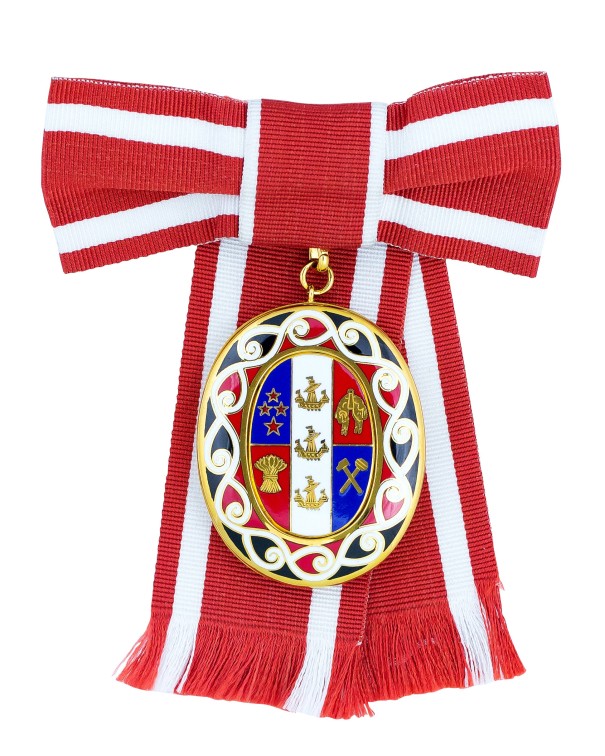
Overview
The Order of New Zealand is New Zealand’s most senior honour. The Order was instituted by Royal Warrant - dated 6 February (Waitangi Day) 1987 - "to recognise outstanding service to the Crown and people of New Zealand in a civil or military capacity.”
For a copy of the Royal Warrant, see the Statutes of the Order of New Zealand (SR 1987/67), on the New Zealand Legislation website.
The Order is a single, first-level Order which is modelled on the (British) dynastic Order of Merit (OM), founded in 1902, and the Order of the Companions of Honour (CH), founded in 1917. The Order was instituted to fill a need for regular access to a first-level non-titular honour (ie, one that did not confer a title on the holder).
Membership
See here for the list of current Members of the Order.
All deceased Members are listed following the current Members.
The King is the Sovereign of the Order. Membership is made up of Ordinary, Additional and Honorary members.
Ordinary membership is limited to 20 living persons at any time.
Additional members may be appointed in commemoration of important royal, state or national occasions. Additional members have the same status as Ordinary members, but are not counted within the limit of 20 living persons (they are ‘additional to’ the Ordinary membership).
Additional appointments have been made on six occasions:
- in 1990 for the 150th anniversary of the Treaty of Waitangi;
- in 2002 for Queen Elizabeth II’s Golden Jubilee;
- in 2007 for the 20th anniversary of the Order;
- in 2012 for Queen Elizabeth II’s Diamond Jubilee;
- in 2022 for Queen Elizabeth II's Platinum Jubilee, and
- in 2023 for the Coronation of King Charles III.
Honorary members are citizens of Commonwealth nations of which The King is not Head of State and of foreign nations. Honorary members have the same status as Ordinary members, but are not counted within the limit of 20 living persons (like Additional members, they are ‘additional to’ the Ordinary membership). Honorary members may be appointed at any time, either as part of a regular Honours List, or in commemoration of important royal, state or national occasions.
Since the Order was established in 1987, 69 Members have been appointed (46 as Ordinary, 21 as Additional, and 2 as Honorary).
Appointments of Members and Administration of the Order
Members are appointed to the Order by The King, on the Prime Minister’s advice.
The Order is administered by a Secretary and Registrar, who is the Clerk of the Executive Council.
Meetings of Members
Members usually meet annually at Government House, Wellington. Traditionally, the spouses of late Members are invited to attend these gatherings.
Meetings have twice been attended by Queen Elizabeth II. In 1990, following the admission of six new members, Queen Elizabeth II held a reception for Members. In 1995, Queen Elizabeth II held a luncheon for Members following the admission of new members.
In 2007, a dinner for all Members was held to celebrate the Twentieth Anniversary of the establishment of the Order. In a speech, the Governor-General "acknowledged the people who have been appointed as Members of The Order of New Zealand for having made a signal contribution to our country". The Prime Minister, in a media release, said "It recognises citizens whose contribution has been truly outstanding".
Insignia
The badge of the Order consists of an oval medallion in gold and coloured enamels, bearing in the centre the design of the shield of the New Zealand Coat of Arms within a Kowhaiwhai rafter pattern. The ribbon is red ochre (kokowai) with a narrow white stripe towards either edge.
The badge is either worn from a neck ribbon or from a ribbon bow on the left shoulder.
The badge must be returned to the Crown on the death of the holder or on the holder ceasing to be a member of the Order. The badge is then passed to another appointee to the order. Often there is a link between the former holder and the new holder of the badge.
The badge of the Sovereign is surmounted by a Royal Crown, and the Secretary and Registrar’s badge by crossed quills.
A lapel badge for Members was instituted in 1990.
The badge is not worn in miniature.
Manufacture
The insignia of the Order was originally made by Spink & Son Ltd., of London, United Kingdom.
